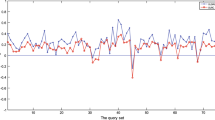Abstract
Linear regression uses the least square algorithm to solve the solution of linear regression equation. Linear regression classification (LRC) shows good classification performance on face image data. However, when the axes of linear regression of class-specific samples have intersections, LRC could not well classify the samples that distribute around intersections. Moreover, the LRC could not perform well at the situation of severe lighting variations. This paper proposes a new classification method, kernel linear regression classification (KLRC), based on LRC and the kernel trick. KLRC is a nonlinear extension of LRC and can offset the drawback of LRC. KLRC implicitly maps the data into a high-dimensional kernel space by using the nonlinear mapping determined by a kernel function. Through this mapping, KLRC is able to make the data more linearly separable and can perform well for face recognition with varying lighting. For comparison, we conduct on three standard databases under some evaluation protocols. The proposed methodology not only outperforms LRC but also takes the better performance than typical kernel methods such as kernel linear discriminant analysis and kernel principal component analysis.








Similar content being viewed by others
References
Bowyer KW (2004) Face recognition technology: security versus privacy. IEEE Technol Soc Mag 23:9–19
Jain AK, Ross A, Prabhaker S (2004) An introduction to biometric recognition. IEEE Trans Circuits Syst Video Technol 14:4–20
Luo J, Crandall D (2006) Color object detection using spatial-color joint probability functions. IEEE Trans Image Prcess 15:1443–1453
Wang JH, You J, Li Q, Xu Y (2012) Extract minimum positive and maximum negative features for imbalanced binary classification. Pattern Recognit 45:1136–1145
Xu Y, Zhang D, Yang J-Y (2010) A feature extraction method for use with bimodal biometrics. Pattern Recognit 43:1106–1115
Xu Y, Zhang D, Yang J, Yang J-Y (2011) A two-phase test sample sparse representation method for use with face recognition. IEEE Trans Circuits Syst Video Technol 21:1255–1262
Cevikalp H, Neamtu M, Wilkes M, Barkana A (2005) Discriminative common vectors for face recognition. IEEE Trans Pattern Anal Mach Intell 27:4–13
Naseem I, Togneri R, Bennamoun M (2010) Linear regression for face recognition. IEEE Trans Pattern Anal Mach Intell 32:2106–2112
Fan ZZ, Xu Y, Zhang D (2011) Local linear discriminant analysis framework using sample neighbors. IEEE Trans Neural Netw 22:1119–1132
Xu Y, Zhang D, Jin Z, Li M, Yang J-Y (2006) A fast kernel-based nonlinear discriminant analysis for multi-class problems. Pattern Recognit 39:1026–1033
Xu Y, Yang J-Y, Jin Z (2003) Theory analysis on FSLDA and ULDA. Pattern Recognit 36:3031–3033
Xu D, Yan S, Zhang L, Lin S, Zhang H, Huang T (2008) Reconstruction and recognition of tensor-based objects with concurrent subspace analysis. IEEE Trans Circuits Syst Video Technol 18(1):36–47
Xu Y, Zhong AN, Yang J, Zhang D (2010) LPP solution schemes for use with face recognition. Pattern Recognit 43:4165–4176
Ching WK, Chu DL, Liao LZ, Wang XY (2012) Regularized orthogonal linear discriminant analysis. Pattern Recognit 45:2719–2732
Lu G-F, Zou J, Wang Y (2012) Incremental complete LDA for face recognition. Pattern Recognit 45:2510–2521
Yang J, Zhang D, Frangi AF, Yang JY (2004) Two-dimensional PCA: a new approach to appearance-based face representation and recognition. IEEE Trans Pattern Anal Mach Intell 26:131–137
Hotta K (2012) Local co-occurrence features in subspace obtained by KPCA of local blob visual words for scene classification. Pattern Recognit 45:3687–3694
Xu Y, Zhang D, Yang J, Jin Z, Yang J-Y (2011) Evaluate dissimilarity of samples in feature space for improving KPCA. Int J Inf Technol Decis Mak 10:479–495
Mika S, Ratsch G, Weston J (1999) Fisher Discriminant Analysis with Kernels. In: Proceedings of neural networks for signal processing workshop. pp 41–48
Zheng W-S, Lai JH, Yuen PC (2010) Penalized preimage learning in kernel principal component analysis. IEEE Trans Neural Netw 21:551–570
He R, Zheng W-S, Hu B-G (2011) Maximum correntropy criterion for robust face recognition. IEEE Trans Pattern Anal Mach Intell 33(8):1561–1576
Kim MY (2013) Accelerated max-margin multiple kernel learning. Appl Intell 38:45–57
Seber GAF (2003) Linear regression analysis. Wiley, New York
Burges CJC (1998) A tutorial on support vector machines for pattern recognition. Data Min Knowl Discov 2:121–167
Dhillon IS, Guan YQ, Kulis B (2004) Kernel k-means: spectral clustering and normalized cuts. In: Proceedings of the tenth ACM SIGKDD international conference on knowledge discovery and data mining. pp 551–557
Scholkopf B, Smola AJ, Muller K-R (1998) Nonlinear component analysis as a kernel eigenvalue problem. Neural Comput 10:1299–1319
Fan J, Heckman NE, Wand MP (1995) Local polynomial kernel regression for generalized linear models and quasi-likelihood functions. J Am Stat Assoc 90:141–150
Nekoukar V, Hamidi Beheshti MT (2010) A local linear radial basis function neural network for financial time-series forecasting. Appl Intell 33:352–356
Barsi R, Jacobs D (2003) Lambertian reflection and linear subspaces. IEEE Trans Pattern Anal Mach Intell 25:218–233
Diosan L, Rogozan A, Pecuchet JP (2012) Improving classification performance of support vector machine by genetically optimising kernel shape and hyper-parameters. Appl Intell 36:280–294
Available: http://www.itl.nist.gov/iad/humanid/feret/feret_master.html
Martinez A, Benavente R (1998) The AR face database. CVC technical report 24
Wright J, Yang AY, Ganesh A, Sastry SS, Ma Y (2009) Robust face recognition via sparse representation. IEEE Trans Pattern Anal Mach Intell 31:210–227
Phillips PJ, Wechsler H, Huang JS, Rauss PJ (1998) The FERET database and evaluation procedure for face-recognition algorithms. Image Vis Comput 16:295–306
Author information
Authors and Affiliations
Corresponding author
Rights and permissions
About this article
Cite this article
Lu, Y., Fang, X. & Xie, B. Kernel linear regression for face recognition. Neural Comput & Applic 24, 1843–1849 (2014). https://doi.org/10.1007/s00521-013-1435-6
Received:
Accepted:
Published:
Issue Date:
DOI: https://doi.org/10.1007/s00521-013-1435-6




